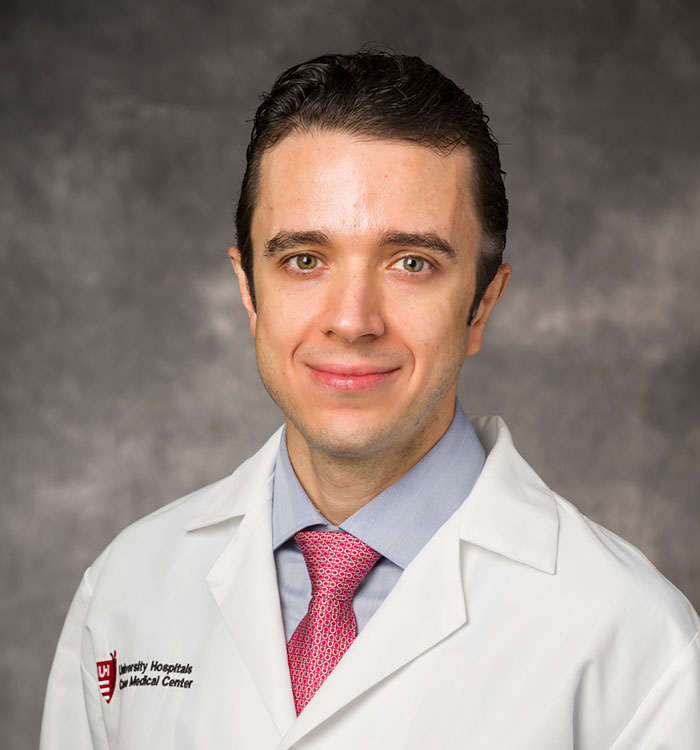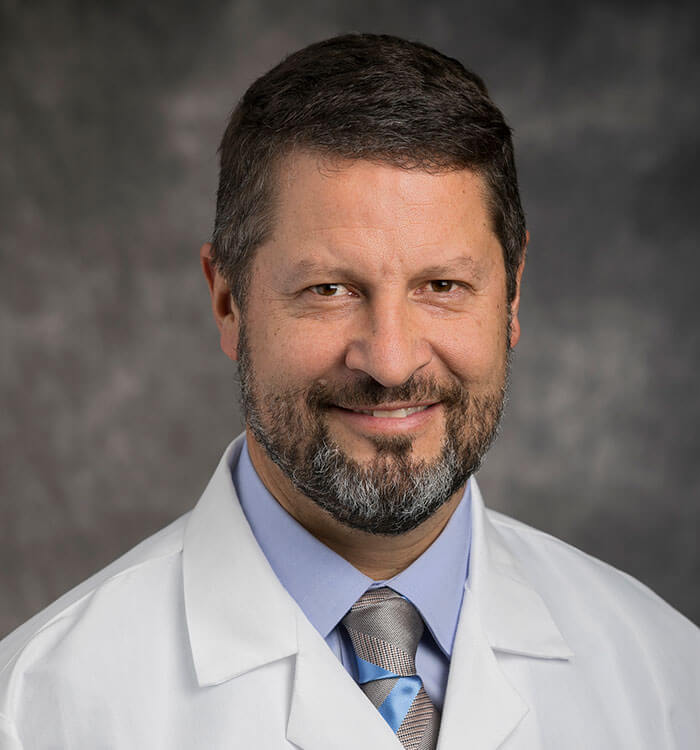Research at Harrington Heart & Vascular Institute Informs Standard of Care for TAVR
June 19, 2023
Younger patients present new challenges
Innovations in Cardiovascular Medicine & Surgery | Summer 2023
University Hospitals (UH) Harrington Heart & Vascular Institute has trained more than 800 clinicians from across the United States in how best to optimize resources for transcatheter aortic valve replacement (TAVR). The UH TAVR team has shown through its published research, for example, that the procedure yields the best patient outcomes when performed with local rather than general anesthesia and without the use of transesophageal echocardiography, which adds cost and risk without benefit. They’ve also shown the safety and benefit of next-day or even same-day discharge after TAVR.
 Guilherme Attazzani, MD
Guilherme Attazzani, MD Cristian Baeza, MD
Cristian Baeza, MDBut that’s just the beginning. Faced with today’s increasingly younger cohort of TAVR patients, the UH team is attacking new challenges, asking new questions and launching new studies aimed at continuing to refine the TAVR standard of care.
“If we want to deliver surgical-like or better than surgical-like results, we have to address several issues that are currently in front of us,” says Guilherme Attizzani, MD, Interventional Director of UH Harrington Heart & Vascular Institute’s Valve and Structural Heart Disease Center. Dr. Attizzani also holds the Alexander and Marianna McAfee Endowed Chair in Innovative Cardiovascular Intervention at University Hospitals.
“The idea is to present a highly customized procedure for every patient,” adds cardiac surgeon Cristian Baeza, MD, Surgical Director of the Valve and Structural Heart Disease Center at UH Harrington Heart & Vascular Institute. “This is a key element when it comes to treating patients that are certainly younger and with longer life expectancy. We need to think in the short, mid and very long term. The patients we are treating today are demanding not just to feel better but most of all to return to a normal life. Over the years and with constant improvement, always looking at our own data, we have been able to offer extremely low rates of any major complication like stroke, vascular accidents or permanent pacemaker implantation. We have moved even further, and we are looking on very refined details like how to implant the valves aligned with the commissures to secure easy access to the coronaries in the future.”
New Issues, New Solutions
Today’s younger TAVR patients want to be able to exercise more vigorously than the more elderly and frail TAVR patients of old, Dr. Attizzani says. That makes minimizing the problem of patient-prosthesis mismatch (PPM) a top priority. Younger patients are also justifiably curious about how long their valve implant will last – an area where there typically haven’t been strong answers, Dr. Attizzani says.
“Unlike prior patients, many TAVR patients today are going to live to see one, two or maybe three valves fail,” he says. “If we treat a 60-year-old patient today, they may live to age 90, so we need to be able to address and understand the durability of these devices.”
Fortunately, research from Dr. Attizzani and colleagues is providing some clarity on this point. In a meta-analysis of 10 randomized controlled trials involving 9,400 patients, published in the American Journal of Cardiology, they compared valve durability among different transcatheter and surgical aortic valve bioprostheses, examining balloon-expandable, self-expandable and surgical aortic valve replacement. The research team found that TAVR with a self-expandable valve demonstrated favorable forward-flow hemodynamics and lowest risk of structural valve deterioration, compared with balloon-expandable or surgical valve at mid-term.
“This a very strong message that there is no concern in terms of the durability of transcatheter valves,” Dr. Attizzani says.
Next, Dr. Attizzani will be looking more closely at how TAVR valves perform under exertion – again, a priority for younger patients who want to remain active. He and his colleagues have received a $450,000 grant from Medtronic to employ UH’s exercise MRI system – one just a few such systems in the country -- to perform stress MRI tests on 90 TAVR patients.
“The goal is to understand how these valves perform under exertion and whether there's going to be a difference between the different platforms that we use,” he says.
Another area of focus for the UH TAVR team has been documenting its use of non-contrast CT for valve sizing – a priority that was adopted many years ago but remains vitally important for many older TAVR patients with kidney disease. The team recently published its experience in the American Journal of Cardiology.
“We were looking at whether we would be able to size our valves with non-contrast CT, and indeed it is feasible,” Dr. Attizzani says. “That’s a very important contribution in terms of minimizing the burden to the patient, minimizing the risk of kidney dysfunction. I presented this data in different conferences, and people are very excited about it. The fact that we can size these patients with non-contrast CT rather than utilization of almost 100 ccs of contrast is very important.”
Dr. Attizzani and his UH colleagues have also published their experience with permanent pacemaker insertion – what he calls the “Achilles heel” of TAVR.
“We wanted to try to understand what we could do to optimize that, to be able to reduce pacemaker rates,” he says. “Because of that, we looked into our own data.”
Writing in the American Journal of Cardiology, the team analyzed more than 1,000 patients who had a TAVR procedure at UH between 2015 and 2021. They noted rates of permanent pacemaker insertion dropped significantly over the study period, hitting a low of 5.7 percent in 2021.
“Along with that, the implantation of the valve was more aortic, and because of that, you have less interaction with the conduction system and therefore lower pacemaker rates,” Dr. Attizzani says.
Another recent innovation for the UH TAVR team is its successful launch of alternative access for TAVR implantation, using the carotid artery.
“When a patient has significant peripheral vascular disease and femoral access is not an option, we used to use the subclavian arteries or the transapical approach,” Dr. Baeza says. “The carotid access has shown to be extremely simple, reproducible and safe. We have more than five cases with 100 percent successful implantation rate, no stroke or any major complication and 100 percent next-day discharge.”
For Dr. Attizzani and Dr. Baeza, these and other innovations are all part of providing personalized care for each individual TAVR patient.
“There are multiple aspects in the procedural planning to understand before we actually go in the room,” he says. “How can we customize care for that specific patient? Today is the era of customization. There is no one size fits all. We have to be much more elegant in this discussion, much more comprehensive in trying to understand what kind of result, what kind of device, what size of device and the depth of the implant. We have to add this amount of granularity.”
“The nature of our group is that we’re always looking to improve and have the best options for our patients,” Dr. Baeza says.
For more information about TAVR at UH Harrington Heart & Vascular Institute or to refer a patient, please call 216-844-3800.
Contributing Expert:
Guilherme Attizzani, MD
Interventional Director, Valve and Structural Heart Disease Center,
UH Harrington Heart & Vascular Institute
Alexander and Marianna McAfee Endowed Chair in Innovative Cardiovascular Intervention
Professor
Case Western Reserve University School of Medicine
Cristian Baeza, MD
Surgical Director, Valve and Structural Heart Disease Center
UH Harrington Heart and Vascular Institute


